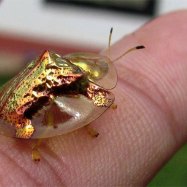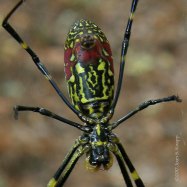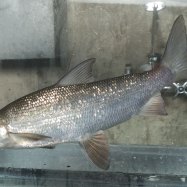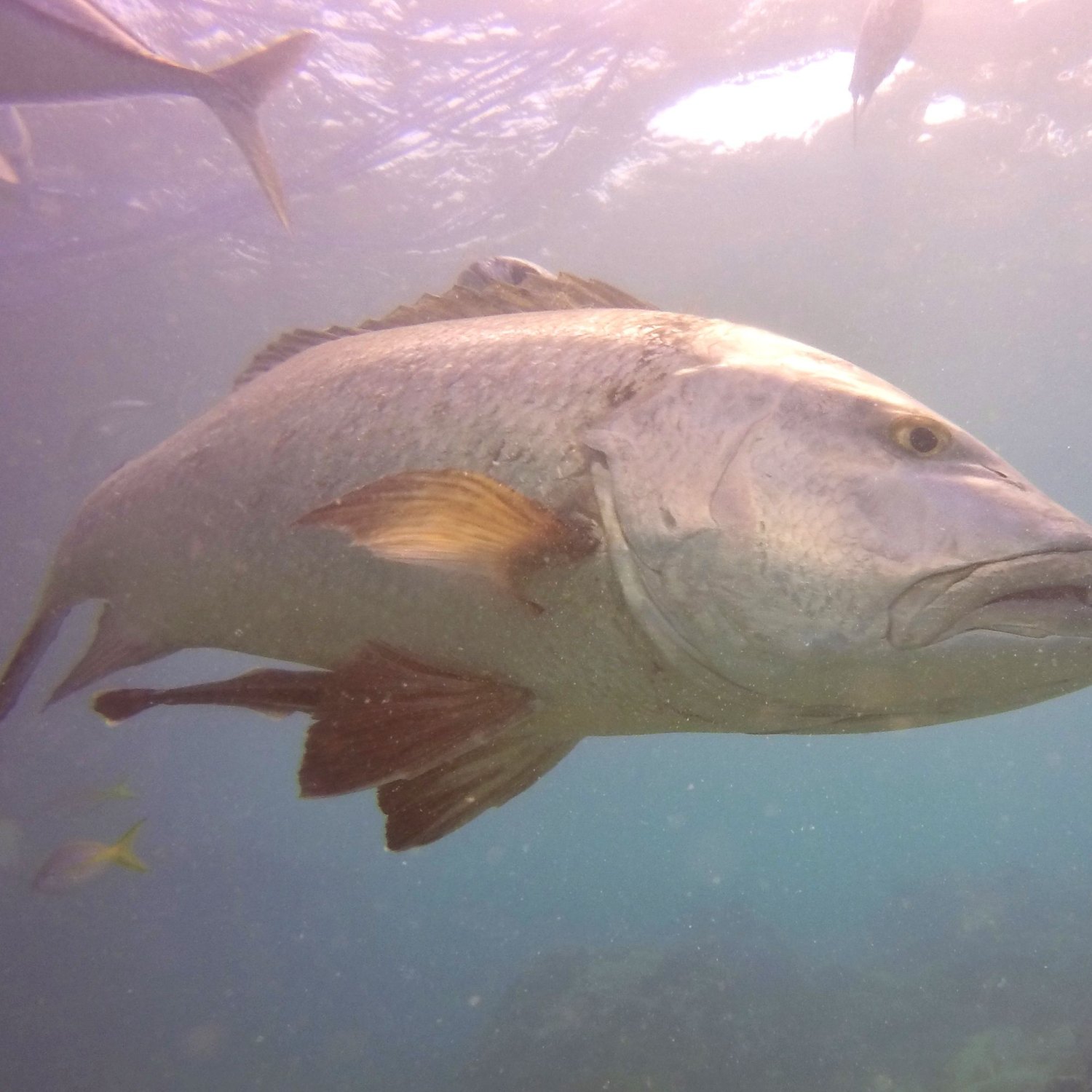
Cubera Snapper
Up to 160 cm
The Cubera Snapper, also known as the Pargo in Latin America, is a fish found in coastal waters. With a maximum length of 160 cm, it belongs to the Lutjanidae family and has an elongated and robust body shape. Its sharp teeth and powerful jaws make it a prized catch for fishermen and a popular dish in many seafood restaurants.
Animal Details Summary:
Common Name: Cubera Snapper
Kingdom: Animalia
Habitat: Coral reefs, rocky bottoms, estuaries
The Fascinating World of the Cubera Snapper
It's a typical sunny day on a Caribbean island, and you are lounging by the crystal-clear waters, sipping on a tropical drink and gazing at the colorful coral reefs. Suddenly, you spot a huge, reddish-brown fish swimming near the shore. Its elongated and robust body catches your eye, and you can't take your eyes off it. What you saw was a Cubera Snapper, also known as Lutjanus cyanopterus scientifically Cubera Snapper. This fascinating creature is a common resident of the Western Atlantic Ocean, with its origins in Cuba. Let's dive deeper into the world of the Cubera Snapper and uncover its impressive features.Kings of the Coral Reefs
As the common name suggests, the Cubera Snapper is a species of snapper fish that belongs to the Animalia kingdom and the Chordata phylum. It is part of the Actinopterygii class, which includes over 30,000 species of ray-finned fish. They are also classified under the Perciformes order and belong to the Lutjanidae family, which includes other popular snappers like the Red Snapper and the Mutton Snapper.The Cubera Snapper is known for its remarkable adaptability and can be found in various habitats such as coral reefs, rocky bottoms, and estuaries. These crafty fish use the protection of the reefs to ambush their prey and seek shelter from predators. They are also known to venture into coastal waters, making them a common sight for snorkelers and divers.
A Predator with a Merciless Appetite
Cubera Snappers have a carnivorous diet, which means they feed on other living organisms Clearnose Skate. They are known to be opportunistic feeders and will consume almost anything they can get their jaws on. Their diet primarily consists of crustaceans, mollusks, and smaller fish like anchovies and grunts. They have been observed hunting in groups, using their sharp teeth to catch and tear apart their prey.Their impressive size, reaching up to 160 cm in length, is no match for their insatiable appetite. Their large mouths and powerful jaws make them dominant predators in their ecosystems, earning them the nickname "kings of the reefs." Despite their predatory nature, they are also preyed upon by larger fish, seabirds, and other marine animals.
A Multicolored Marvel
One of the most striking features of the Cubera Snapper is its coloration. As mentioned earlier, their upper body ranges from reddish-brown to gray, while their lower body is lighter. This coloration serves as camouflage, helping them blend into their surroundings and avoid detection from predators. It also helps them ambush their prey by blending in with the coral reefs.Aside from their coloration, they also have a unique body shape. The Cubera Snapper's body is elongated and robust, with a slightly pointed snout. This shape, along with their powerful tail fins, allows them to swim quickly and maneuver through the coral reefs with ease. Their streamlined body also makes it easier for them to hunt and capture prey.
A Coveted Catch for Anglers
Apart from being a majestic creature in its natural habitat, the Cubera Snapper is also a highly sought-after catch for recreational and sport fishermen. Due to their large size and ferocious nature, they are considered a challenge for anglers to hook and reel in. This has led to overfishing, and as a result, the Cubera Snapper is considered a vulnerable species. In some areas, strict fishing regulations have been put in place to protect their population.The Cultural Significance of the Cubera Snapper
In addition to being a prized catch for fishermen, the Cubera Snapper also holds cultural significance in Cuban cuisine and folklore. In Cuba, the Cubera Snapper is known as "Cubera" or "pargo rojo," and it is a popular dish on the island. It is often prepared whole and grilled with various spices and served with rice and beans, a staple dish in Cuban cuisine.In Cuban folklore, the Cubera Snapper has also been referenced in stories and legends. One popular tale tells of a mysterious and monstrous Cubera Snapper that lurks in the deep waters. This legend has sparked the imagination of many, and some have even claimed to have seen the giant snapper while out at sea.
Threats to the Cubera Snapper Population
Sadly, the Cubera Snapper's population is declining due to various threats, including overfishing, habitat destruction, and pollution. As mentioned earlier, strict fishing regulations have been put in place in some areas to protect their population. However, more needs to be done to protect these majestic fish and ensure their survival.One of the ways that scientists and conservationists are working towards protecting the Cubera Snapper is through monitoring and tracking their movements and behaviors. This involves using satellite tagging and acoustic tracking technology to gather data on their migration patterns and habitats. This information is vital in creating conservation plans and better understanding the species' needs.
Protecting the Kings of the Reefs
As we continue to learn more about the Cubera Snapper, we must also remember that we play a crucial role in protecting these kings of the reefs. As tourists, we must practice responsible snorkeling and diving to avoid damaging their homes, the coral reefs. As fishermen, we must follow regulations and practice sustainable fishing practices to help their population recover.Furthermore, as individuals, we can play our part by reducing pollution and preserving our oceans' health. Doing so will not only benefit the Cubera Snapper but also the countless other marine animals that call the ocean their home.
In conclusion, the Cubera Snapper is a magnificent creature that thrives in the vibrant and diverse ecosystem of the Western Atlantic Ocean. Its impressive adaptability, predatory nature, and cultural significance make it a fascinating species to learn about. Let's work together to protect and preserve these kings of the reefs for generations to come.

Cubera Snapper
Animal Details Cubera Snapper - Scientific Name: Lutjanus cyanopterus
- Category: Animals C
- Scientific Name: Lutjanus cyanopterus
- Common Name: Cubera Snapper
- Kingdom: Animalia
- Phylum: Chordata
- Class: Actinopterygii
- Order: Perciformes
- Family: Lutjanidae
- Habitat: Coral reefs, rocky bottoms, estuaries
- Feeding Method: Carnivorous
- Geographical Distribution: Western Atlantic Ocean
- Country of Origin: Cuba
- Location: Coastal waters
- Animal Coloration: Reddish-brown to gray on the upper body, lighter on the lower body
- Body Shape: Elongated and robust
- Length: Up to 160 cm
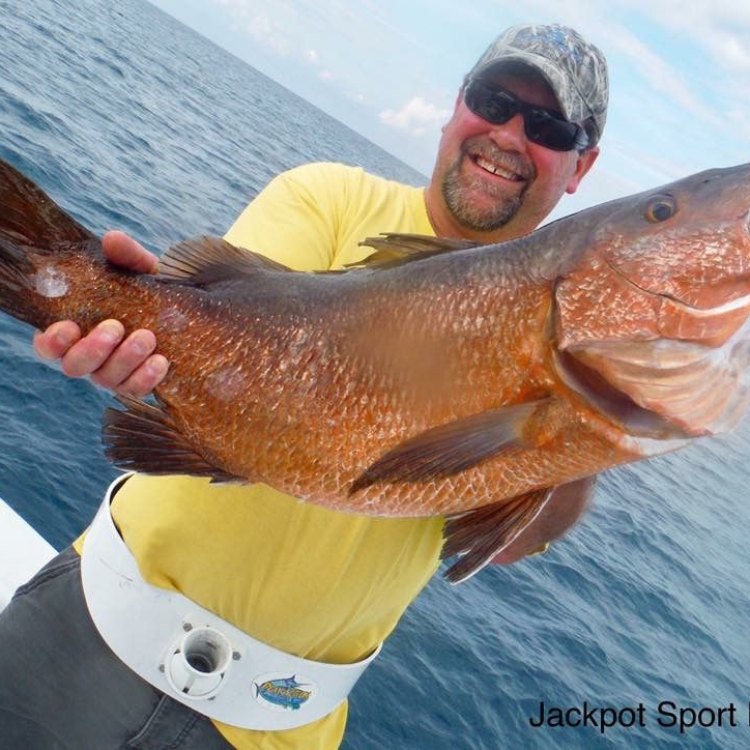
Cubera Snapper
- Adult Size: Around 50 to 70 cm
- Average Lifespan: Up to 34 years
- Reproduction: Sexual
- Reproductive Behavior: Spawning in large aggregations
- Sound or Call: No specific sound or call
- Migration Pattern: Unknown
- Social Groups: Solitary or in small groups
- Behavior: Nocturnal and territorial
- Threats: Overfishing, habitat destruction
- Conservation Status: Vulnerable
- Impact on Ecosystem: Top predator in the ecosystem
- Human Use: Commercial and recreational fishing
- Distinctive Features: Large size, powerful jaws, red coloration
- Interesting Facts: Cubera Snapper is known to migrate long distances to spawning sites.
- Predator: Sharks, other large predatory fish

Lutjanus cyanopterus
The Mighty Cubera Snapper: The Ultimate Predator of the Sea
The ocean is a vast and mysterious world, filled with a diverse array of creatures. Among these creatures is the Cubera Snapper, a formidable predator that rules the waters with its imposing size and powerful jaws. This incredible fish has captured the imagination of fishermen, researchers, and ocean enthusiasts for decades. In this article, we will dive deep into the world of the Cubera Snapper, exploring its unique features, behavior, and role in the ecosystem PeaceOfAnimals.Com.The Cubera Snapper, also known as the Cubera Cichlid, is a species of fish that belongs to the Snapper family. It can be found in the western Atlantic Ocean, from North Carolina all the way down to Brazil. This large and voracious fish primarily inhabits coral reefs and rocky areas, although it can also be found in estuaries and mangrove swamps. It is a solitary or small group species, with adults ranging from 50 to 70 cm in length, and can weigh up to an impressive 100 pounds. With a lifespan of up to 34 years, this fish can grow to be a true sea giant.
One of the most distinctive features of the Cubera Snapper is its striking red coloration. This eye-catching color is mostly seen in the adults, while the juveniles showcase a grey or brown color with light stripes. The red hue of the fish is a result of its diet, which includes smaller fish, crustaceans, and mollusks. The pigments present in these prey items accumulate in the skin of the fish, giving it a vibrant red appearance Childrens Python. This color not only makes them stand out in the ocean but also serves as a warning to potential predators of its potent venomous spines.
While the Cubera Snapper is an impressive fish in terms of size and appearance, its behavior is equally fascinating. As a nocturnal species, it spends its days hiding in crevices and holes, only becoming active at night to hunt for food. This fish is also known to be territorial and aggressive, using its powerful jaws and sharp teeth to defend its territory. It is not uncommon to see two Cubera Snappers engaged in a fierce battle for dominance in their habitat.
Reproduction in the Cubera Snapper follows a sexual pattern, with spawning occurring in large aggregations. These aggregations, or groups, are made up of both males and females and can consist of hundreds or even thousands of individuals. During spawning, the fish release millions of eggs, which are then fertilized by the male. The fertilized eggs then drift away and hatch into larvae, eventually settling into the rocky or coral substrate. Interestingly, Cubera Snappers have been observed to migrate long distances from their habitats to specific spawning sites, highlighting their determination to reproduce.
Despite being a top predator in the ecosystem, the Cubera Snapper itself faces several threats. One of the main threats is overfishing, as this fish is commercially valued for its meat and is also a popular catch for recreational fishermen. Additionally, habitat destruction through activities like coastal development and pollution also poses a significant threat to its population. As a result, the IUCN has listed the Cubera Snapper as a vulnerable species, highlighting the need for conservation efforts to protect it from extinction.
The impact of the Cubera Snapper on the ecosystem is crucial, as it plays a significant role in maintaining balance and diversity. As a top predator, it helps regulate the population of smaller fish, preventing them from overgrazing on algae and causing damage to the reefs. Its presence also indicates a healthy ecosystem, as they are sensitive to environmental changes and can serve as indicators of any issues in the ocean.
Humans have a long history of exploiting the resources of the ocean, and the Cubera Snapper is no exception. It has been a popular catch for both commercial and recreational fishing, with its large size and tenacious fight making it a sought-after trophy for fishermen. However, as its population declines, there have been efforts to regulate fishing activities to ensure sustainable catch and protect this magnificent fish.
While the Cubera Snapper's large size and powerful jaws make it an imposing predator, it is not without its own predators in the ocean. Sharks, barracudas, and other large predatory fish are known to prey on the Cubera, making it constantly vigilant for potential attacks. This dynamic adds to the mystique and aura of this remarkable fish, evoking a sense of respect and admiration.
In conclusion, the Cubera Snapper is a truly remarkable species that occupies a special place in the ocean. Its impressive size, striking red coloration, and formidable behavior make it a fascinating subject for research and observation. As we continue to explore and learn more about this incredible fish, it is our responsibility to ensure its survival and conservation for future generations to marvel at its splendor.
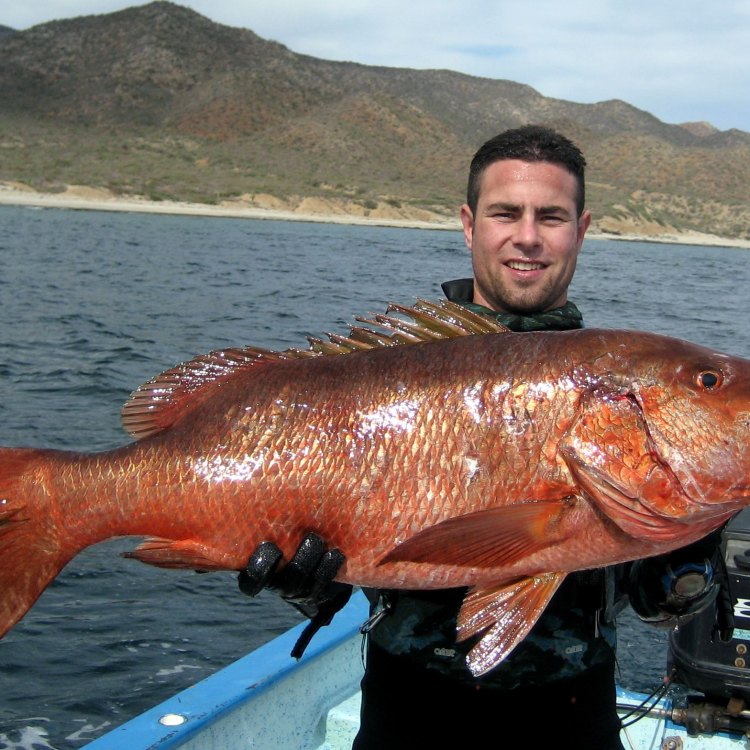
The Fascinating World of the Cubera Snapper
Disclaimer: The content provided is for informational purposes only. We cannot guarantee the accuracy of the information on this page 100%. All information provided here may change without prior notice.


